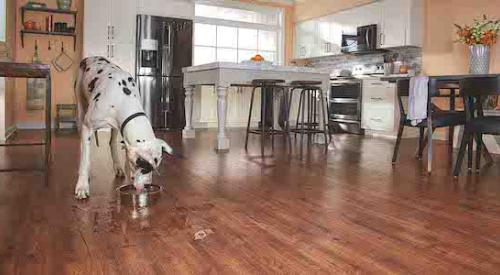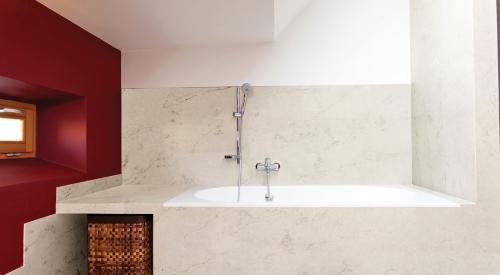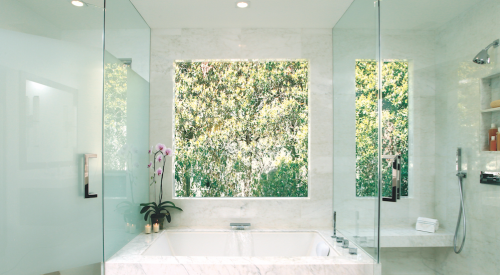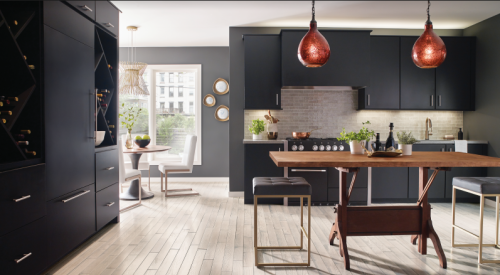
From Karndean Designflooring’s Da Vinci Collection, acacia luxury vinyl tile replicates the look of weathered, burnt timbers without the drawbacks of cracking, splintering, or warping, which can occur with real wood.
What’s your guess as to the most installed flooring material in new U.S. homes last year? Across starter, move-up, and luxury price points, it was carpeting, according to the Home Innovation Research Labs Annual Builder Practices Survey. Runners-up are solid hardwood and ceramic tile, then engineered hardwood, followed by vinyl sheet or tile, laminate, and natural stone and other materials. But statistics alone don’t tell the complete story of what’s most popular—and what’s losing favor—with consumers. Delving more deeply into Home Innovation’s findings shows that over the past 12 years, carpeting has actually lost ground, plunging 20 points from its former 60 percent share.
Area Rugs vs. Carpets
Designer Lita Dirks, CEO of Lita Dirks & Co., in Greenwood Village, Colo., cites several reasons for carpeting’s decline. It tends to collect and hold dirt and allergens; with indoor air quality a concern, many are choosing other materials. In addition, hardwood remains popular, leading to a higher demand for area rugs. “The layering of materials provides homeowners with the same comfort and warmth that carpeting does, while also producing pops of personality in a space,” Dirks says.

Flor mix-and-match carpet tiles can create the look of layered rugs without the layering. Shown are the two-tone, dual-textured Antique Minx, the Oriental-rug inspired Reoriented, and Nizhoni Patchwork that draws elements from the American Southwest. “The wide variety of [carpet tile] colors and arrangement options, along with the ability to tailor the tile to a room’s layout, makes them an inspired outlet for expressing a homeowner’s individuality and personality,” designer Lita Dirks says.
Mary DeWalt, owner of Mary DeWalt Design Group, in Austin, Texas, explains that hard-surface flooring materials are much more practical and universal, wear much longer, and are easier to clean. “Carpet is still very popular in bedrooms,” but hard surfaces are making their way into that room, too, she says.
“Many buyers are choosing to put more money into their kitchens, main flooring, and master bathrooms, and opting for more standard carpets in secondary rooms and bedrooms with an upgraded pad,” explains C.J. Ametrano, national merchandising manager for Horsham, Pa.-based Toll Brothers. “Carpet is the easiest to replace over time, so this is not always the priority in flooring purchases.”
What’s on-trend, Dirks says, are carpet tiles. “If damaged, only the affected tiles need replacing, making it low maintenance and cost friendly.”
Wood Endures
According to the Home Innovation survey, the largest gains over the past 12 years have been in solid and engineered hardwood floors, with modest increases for ceramic tile and a recent slight boost for luxury vinyl tile. Although carpeting is most popular in the Midwest, with slightly more than 50 percent share in new-home flooring, it’s the least popular in New England, claiming just 18 percent, with solid hardwood the winner at 52 percent.

Armstrong Flooring’s TimberBrushed hardwood achieves its weathered texture through the removal of the soft portion of the wood to expose the grain. Lining and deep etching further enhance dimension.
“Generally speaking, wood flooring is the most preferred option throughout the country,” Ametrano says. “With the popularity of great rooms, the flooring is continued from the entry to the great room, kitchen, and powder room. In two-story homes, many prefer to include wood on the stairs, stair landing, and into the master bedroom.” DeWalt agrees. “We’re seeing buyers use wood throughout living, kitchen, and bedroom areas with the exception being wet areas, where most still prefer tile,” she says. Planks range in width and can be mixed for dramatic effect. Dark, light, gray, and natural are all popular hues, and white oak, white-washed, and low-luster finishes will continue to grow in popularity, DeWalt says. “Patterns are popular as well in smaller spaces, such as bathrooms and laundry rooms,” says Kari Deol, Design Studio director of The New Home Company, in Aliso Viejo, Calif.
“The market continues to trend toward longer, wider planks and random widths,” says Sara Babinski, design manager for hardwood and laminates at Armstrong Flooring, in Lancaster, Pa., who says that wide-width planks create a sense of openness. She reports numerous requests for recommendations regarding the mixing of colors on the floor to create a patchwork. “Rustic and distressed looks featuring mineral streaking, knots, hand-scraping, and wire brushing that aim to add character also continue to rise in popularity across the country,” Babinski notes.
“A popular finish right now is what we are calling Greige—a mixture between gray and beige, often with a driftwood look,” Ametrano says. “Other favored tones are cool brown as well as blond wood. The woods that are in favor vary by region and by demographics, from rough-hewn wood planks to variations of sculpted woods to a satin finish engineered hardwood.”
The Home Innovation survey notes that engineered hardwood does well in Southern states, in the Pacific Northwest, and in some intermountain areas, such as Colorado, Utah, and New Mexico. Babinski says that in addition to good looks, buyers also want floors that perform, noting that acrylic-infused engineered wood can hold up twice as well as traditional wood against scratches, dents, and scuffs.
Look-Alikes on the Rise
Whether it’s laminate, vinyl, or ceramic, the most popular patterns are those that mimic the look of natural materials. A strong trend right now is wood-design porcelain planks, says Ametrano, adding that some manufacturers provide porcelain wood planks by species that look quite realistic, thanks to advances in 3-D printing.

Artistic Tile’s Silverwood wood-look porcelain infuses a weathered wood-look plank with shots of metallic silver. Six colors are offered in the collection.
Variation in porcelain tile size is also on trend, with new sizes such as the 24-by-48-inch large format being popular for homes in warm climates with indoor/outdoor living. “Finishes and colors in tile vary from wood-look textured finishes and wire-brush finishes to vein-cut and cross-cut natural stone designs,” she says. Along with different options, homeowners want a seamless, continuous flow from room to room with the same flooring throughout (especially on the main floor), Dirks observes. “The largest trend we’ve seen in the past five years is continuing the color tone from the interior to the outdoor living areas,” Ametrano says. “This may be the same product, in the case of natural stone and porcelain tile used indoors/outdoors. And in the case of the hardwood-to-outdoor transition, many [homeowners] are choosing matching wood-look porcelain tile or other products in the same tone as the flooring."
Swayed or Savvy?
Tune in to any House Hunters episode on HGTV and most homebuyers seem set on hardwood floors. Is the media having an effect on homeowners’ flooring preferences? “Buyers are swayed by what they see in the media,” says Deol, who observes that hardwood floors are viewed by some as a status symbol, in the way that granite countertops achieved must-have status a few years ago.
“Often, homeowners are overwhelmed with the huge variety of flooring options and thus go with what they’re most familiar with,” Dirks points out. She adds that homeowners may not realize the variety of additional flooring products available—and that luxury vinyl and laminate are no longer frowned upon. There are a wide variety of quality and budget-friendly choices beyond hardwood. “It just takes time for exposure and acceptance of these new selections,” Dirks says. It’s also important to learn what types of flooring products are better or worse in certain climates.
“Homeowners are more design savvy now than ever due to HGTV, Houzz, and Pinterest, which also can lead them to be more adventurous,” DeWalt says. “There are a number of luxury vinyl products that look exactly like wood but are more resilient, and many of the builders we work with are adding them to their design centers. Large-format porcelain and ceramic tiles that emulate stone and marble are also gaining in popularity and go from inside to outdoor patios.”
The Home Innovation survey notes that water resistance has made vinyl popular for wet, messy areas of the home. But vinyl has recently lost share to ceramic tile, which is now being used more in the living, dining, and family rooms, as well as in bathrooms and bedrooms, where carpeting traditionally held sway.

Appalachian Flooring’s Special FX Collection includes a Metal FX coating that uses real metallic flakes to create wood floors that have the look and sheen of stainless steel. Oak and maple options are also available.
Mad for Mod
Clean-lined modern styling is gaining ground over traditional looks across the generations. “Homes designed for Millennials and Gen-Xers lean to contemporary, though many also choose more transitional styles,” Ametrano says. “Baby Boomers are getting younger and younger by mindset, and many are choosing the more streamlined designs and trends for their homes as well. Active adults 65-plus tend to stick with transitional to traditional choices.”
But when it comes to eco-friendly flooring, greenbacks trump green, DeWalt says. “Most people like the idea of ‘green’ flooring,” according to Ametrano, “but don’t want to pay the additional cost to have it.” Cork, bamboo, and concrete—edgy newcomers a couple of decades ago—are past their prime. “We don’t get requests for these much,” Deol says. As lifestyles change and consumer product awareness increases, the world of flooring will continue to grow in the number of creative options and innovations it offers.
For more on the latest in flooring, click on the slideshow below. PB
Wanda Jankowski is based in New York and writes about home design.












